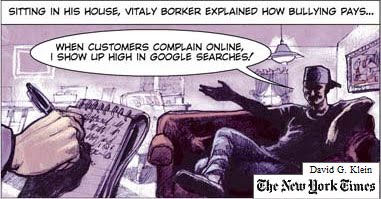Negative Reviews Can Now Affect Site Rank Downward

One of the ongoing truths about search engine optimization (SEO) has been that inbound links are usually a good thing. This has caused SEO scammers to abuse the practice by creating and using “link farms,” sites that exist solely to link back to client sites. This “spamdexing” technique is based on having many of these sites (hundreds, thousands) with nothing but links. Quite some time ago Google, Yahoo, and other search engines from the mists of history all recognized this bad practice and started penalizing sites listed on those indices.
When you get SEO spam email claiming that the spammer will list your site in 300 (or some other large number) search engines, this is often what they mean. If you can name more than three search engines, you are already ahead of most Internet users and you recognize that 50, 100, 300, etc are all untenable numbers. If you get an email from someone saying he or she likes your site, has linked to it, and wants you to link back, it’s probably just another link farm.
Sadly, with the proliferation of community and social media sites that allow users to post comments and rate organizations, we see a repeat of the comment-spamming model that has caused blogs (among others) to implement CAPTCHA and other Draconian measures to try and hold back the tide of comment spam. As the adage “all press is good press” has led us to believe, coverage of any sort is good for business. That also means that sites that track comments about business, such as Epinions, Get Satisfaction and others like them, can end up boosting an organization’s rank in the search engines even when customers complain about the organization. Let me restate — if people had anything to say about you, including bad things, they were giving you a bump in search engine results.
Cue an article in the New York Times, A Bully Finds a Pulpit on the Web, which tells the story of a woman who purchased a pair of glasses from a company that appeared at the top of the Google search results. Not only did she not get the product she wanted, it took a decidedly Single White Female turn and became a real life game of harassment from the vendor. The motivation for the vendor to behave this way is pretty clear from a comment on Get Satisfaction, posted by the very person harassing the customer.
Hello, My name is Stanley with DecorMyEyes.com. I just wanted to let you guys know that the more replies you people post, the more business and the more hits and sales I get. My goal is NEGATIVE advertisement.
When you see comments like these from “Michael” on Get Satisfaction, you can see how Michael’s constant “complaints” are really doing nothing more than acting as link machines back to the offender’s site. You decide if Michael is a real person or just part of the link spamming.
While this is an extreme case, it was enough for Google to take notice. On December 1 Google announced that it has made changes to its search algorithm (Being bad to your customers is bad for business):
[W]e developed an algorithmic solution which detects the merchant from the Times article along with hundreds of other merchants that, in our opinion, provide an extremely poor user experience. The algorithm we incorporated into our search rankings represents an initial solution to this issue[…]
Google makes some fair points about blocking (or lowering the rank of) an organization’s site outright that has negative commentary associated with the organization. In that scenario, many politician sites would fare poorly. Competing organizations can engage in a war of defamation on third party sites. And so on.
What’s key about Google’s statement is the phrase “extremely poor user experience.” This goes beyond just poor customer service and defective products, and can now capture sites where people complain about the design or the usability. I am one of those people who has reached out to a site to complain about a technical or implementation problem (yes, I am that jerk) and, when faced with no response, have taken to the critique sites to restate my case (complaint, whining, whatever). If you get enough user experience (UX) designers to complain about a site’s ability to confound, or enough disabled users to complain about a site’s inaccessibility, those can now impact a site’s overall Google rank.
As you read the Times article, remember that even if your organization would never behave that way, if your site is impossible to use and people say so on opinion sites, then you could fall into the same bucket.
While you’re considering that, make sure your site loads quickly, too (see the last link below).
Related
- Beware The Link Farms – Avoiding Mistakes In SEO Link Building
- A Bully Finds a Pulpit on the Web
- Being bad to your customers is bad for business
- Your Site Speed to Affect Its Google Rank
Leave a Comment or Response